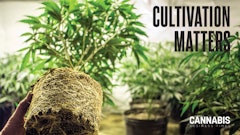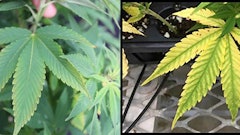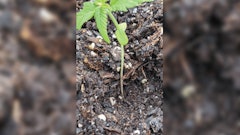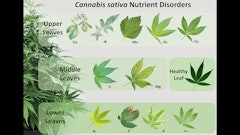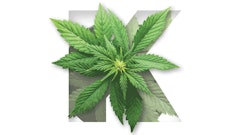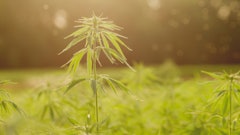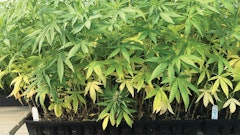

Macro- and micronutrients help plants grow properly, obtain optimal yields, and complete their lifecycle. Substantial quantities of the essential macronutrient magnesium (Mg) is necessary for proper plant growth and development. In plants, Mg is a mobile element that is used in photosynthesis and protein synthesis. Therefore, Mg is often moved (translocated) in the plant from the older leaves to satisfy the demand in newer developing leaves that are often more photosynthetically active. Given Mg is the central atom of the chlorophyll molecule, which converts light energy into essential carbohydrates, Mg is directly related to optimal plant growth. Cannabis is a determinate plant, which means that once flowering begins, the terminal growing tips develop into floral material. Mg will directly impact the size, quality, and yield of a plant, which will directly impact the grower’s bottom line.
Even though Mg is needed in large quantities, an overapplication of Mg can stunt plant growth. Additionally, an excess of this divalent cation (a positive element with two charges that allow two other negative elements to attach) can cause nutrient antagonisms—when there is an excessive amount of one nutrient, it can limit the plant’s ability to uptake adequate levels of other nutrients. This can lead to imbalances from nutrients being unavailable. Thus, with Mg nutrition, there exists a specific range in which fertility is optimized, but not overapplied. The Mg rates study conducted at North Carolina State University (NCSU) sought to determine the rate of Mg fertility that would optimize plant growth and total flower weight produced. This experiment explored the impact of Mg fertility rates on the production of above ground biomass and Mg uptake of cannabis plants.
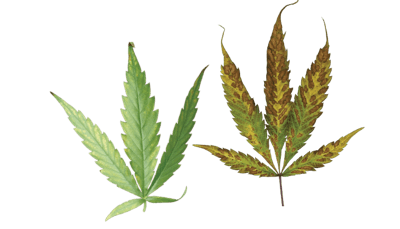
Photos by Patrick Veazie
Vegetative Symptoms of Mg Deficiency
Magnesium deficiency can easily develop in cannabis plants and can manifest as a variety of symptoms. Initial symptoms of Mg deficiencies manifest as slight yellowing of the interveinal regions of the lower and older foliage. In the early stages of Mg deficiency, cannabis plants will exhibit stunted growth when compared to plants with adequate Mg.
Chlorosis caused by a Mg deficiency will appear as a marginal yellowing of the lower leaves. The interveinal chlorosis at the leaf tips will spread into the leaf margins, and prolific interveinal chlorosis will develop on the lower foliage of the plant. As symptoms of Mg deficiency progress, the interveinal chlorosis will advance inward toward the center of the leaf (Fig. 1).
In advanced stages, the chlorosis will spread inward to the center of the leaf. As chlorosis develops, leaves will eventually become necrotic (death of plant cells) (Fig. 2). Additionally, as these symptoms progress in the older leaves, the interveinal chlorosis will advance up the plant to the mid and upper foliage (Fig. 3). Growers will often observe Mg deficiency symptoms after bud formation has begun. With Mg being a mobile element, the symptoms often are induced with the formation of buds acting as a “sink” for the plant (Fig. 4), as plants prioritize reproduction and will direct resources to the floral sink at the expense of leaves. If Mg deficiency is occurring early during the vegetative stage of cannabis production, growers need to take corrective action before the start of bud development to prevent a decrease in bud size.
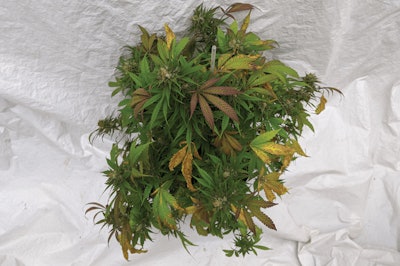
How to Determine Mg Deficiency
The symptoms of Mg deficiency are similar to other nutrient deficiencies such as potassium (K) and iron (Fe). Often Mg deficiency occurs later in the vegetative growth stage or during bud formation and begins on the lower, older foliage. Potassium deficiency, which also exhibits interveinal chlorosis of the lower, older foliage, often occurs much earlier in the vegetative stage. However, the onset of bud production can also accelerate deficiencies. Interveinal chlorosis may also be caused by Fe deficiency. However, plants being grown in Fe-deficient conditions will exhibit foliar symptoms in the upper foliage. In this case, the location of the foliar symptoms can be used to determine whether the plant is deficient in Mg (lower foliage) or Fe (upper foliage). That said, growers should perform foliar nutrient analysis before making fertility adjustments.
Floral Symptomology of Mg Deficiency
Magnesium plays many key roles in plant development, including chlorophyll production as well as protein synthesis. Once flower initiation begins, adequate Mg levels are needed for proper bud development. Flowering cannabis plants grown under acute Mg-deficiency may not exhibit foliar symptomology yet still have a reduction in biomass. Flowering plants grown under Mg deficient conditions in the NCSU study did not exhibit symptoms on the buds themselves, but still resulted in less total bud dry weight when compared to plants that were provided adequate Mg. However, plants that received 100 ppm Mg produced less total bud dry mass than those grown at the rates of 50 to 75 ppm Mg. Thus, providing the correct range of Mg is essential to maximize total bud weight production.

Photo by Brian Whipker
Magnesium Fertility Rates
Given the results of our research, we believe that the optimal fertilization range of Mg for cannabis is between 50 and 75 ppm Mg provided throughout the production cycle, which is slightly higher than most other crops, which average between 25 and 50 ppm Mg. At these rates, plants were significantly larger in total plant above-ground dry weights when compared to the plants grown at 0 ppm Mg. Researchers controlled for Mg from other sources, including irrigation water. The leaf tissue concentration had an increased accumulation for all rates, with the highest rate resulting in the highest concentration of Mg (100 ppm Mg). Magnesium also has a large impact on the flower production of cannabis, meaning growers experiencing Mg deficiency could see a large negative impact on profits. However, providing Mg at the recommended rates and above resulted in similar cannabinoid concentrations. Therefore, based on our research, there is not any benefit of providing more than 75 ppm Mg to the plant.
Corrective Measures for Magnesium Deficiency
The symptoms exhibited by Mg deficiency can be misinterpreted for other deficiencies; therefore, further analysis of leaf tissue is needed to confirm the proper deficiency. Many factors play into Mg deficiency, including an insufficient supply of the nutrient, imbalanced soil pH, or imbalanced fertility, which can lead to antagonism caused by other nutrients (such as excessive potassium (K), calcium (Ca), or sodium (Na)). Growers should determine if there is any Mg being supplied by their irrigation water source. If levels are found to be too low, supplemental applications of magnesium sulfate can be added in order to achieve the desired 50 to 75 ppm target range. Magnesium nitrate is also a good source for Mg and nitrogen (N) and can be used as long as the fertilization program is balanced to provide adequate fertility levels. If deficiency symptoms develop, a common application method used to correct the problem is to apply a heavy dosing drench of magnesium sulfate at the rate of 2 pounds per 100 gallons of water.
Conclusions
Given the critical role Mg plays in photosynthesis and synthesis of proteins in the growing and developing portions of plants, and that the most valuable portion of cannabis is the determinately produced flowers, Mg fertility has a direct impact on cannabis profitability. Given this data, Mg fertility rates within the 50 and 75 ppm Mg range optimized total plant dry weight and leaf tissue accumulation of Mg without resulting in overapplication or deficiency symptoms.
Patrick Veazie is an undergraduate researcher in the Department of Horticultural Science at North Carolina State University.
Dr. Brian E. Whipker, Ph.D., is a professor of floriculture at North Carolina State University specializing in plant nutrition, plant growth regulators and diagnostics.
Paul Cockson is a Ph.D. student at the University of Kentucky's Horticulture department. He is a part of the controlled environment horticulture (CEH) lab and is conducting research on plant nutrition and abiotic stress impacts on greenhouse vegetable quality and fruit development.
David Logan is an undergrad research assistant in the Department of Horticulftural Science at North Carolina State University.
Dr. W. Garrett Owen is an assistant professor and extension specialist of floriculture, greenhouse, and controlled-environment crop production in the Department of Horticulture at the University of Kentucky.











